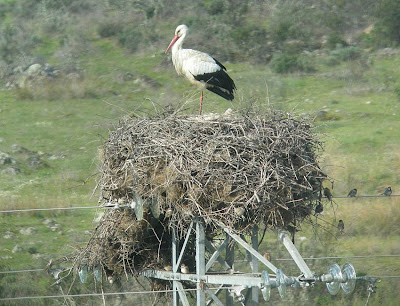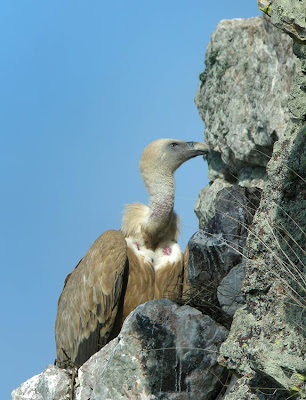In addition to the events listings in Bird Watching magazine, we will be listing birdwatching-related events on this blog. Scroll down the sidebar to just below Breaking News, click on the link, and you'll find April 2008's events.
If you have an event that you'd like added to the listings, email us at:
birdwatching@emap.com and we'll post it.
Monday, March 31, 2008
Events
Posted by
Mike Weedon
at
3:42 PM
0
comments
![]()
![]()
Friday, March 28, 2008
May 2008
Now in a shop near you...
Our May 2008 issue is packed with advice and inspiration to help you get more from your birding this month:
Major binoculars survey. An in-depth look at four of the best 8x32 binoculars on the market.
Finders keepers. Seven unmissable pages to help you find that bird-of-a-lifetime.
How to photograph birds in flight. All you need to make your garden the place to photograph birds.
Win! A holiday in bird-rich Scotland.
Go Birding. 10 exciting bird walks for the month of May.
Photography special. Portraits of London Grey Herons.
Secret lives: Fascinating facts about the Great Crested Grebe.
Identify: Kites and Marsh Harrier in flight.
It's all in the May 2008 issue of Bird Watching magazine. Don't miss it!
Plus Plus PLUS – Ten new Go Birding walks to try; unique site-by-site guide to all the best birds of March 2008; page after page of ideas for May birding, and so much more!
Go buy it! Or subscribe here:
Posted by
Mike Weedon
at
11:24 AM
0
comments
![]()
![]()
Labels: bird, birding, Birdwatching, magazine, photography
Tuesday, March 25, 2008
Drummer
Drumming Great Spotted Woodpecker digiscoped in video by Mike Weedon at Woodwalton Fen NNR, Cambs, on 24.3.08.
Pump up the volume!
Posted by
Mike Weedon
at
1:56 PM
1 comments
![]()
![]()
Thursday, March 20, 2008
Out now!
 Production Editor Matt Merritt writes:
Production Editor Matt Merritt writes:
I’m going to ask all of you out there to allow me to indulge in a spot of shameless self-promotion for a few moments.
When I’m not hard at work here at Bird Watching Towers (gazing out of the window trying to add to our year list), I dabble in the world of poetry, and my first full-length collection has just been released by Arrowhead Press. It’s called Troy Town, it’s in hardback, it’s 80 pages long, and the splendid cover pic was taken by Bird Watching photographer Tom Bailey. Not surprisingly, given my interests and line of work, there are plenty of birds in the poems, although there are plenty of other things too.
Should any of you wish to buy a copy (£8.99 including p&p), you can do so here, or directly from me, at my Troy Town blog, which contains further information, reviews, etc.
Posted by
Mike Weedon
at
11:36 AM
0
comments
![]()
![]()
Labels: Arrowhead Press, Poetry
Wednesday, March 19, 2008
Flight photography

Assisitant editor Mike Weedon writes:
In our May issue, we will have a special practical feature by Elliott Neep on photographing birds in flight. Kevin Wilmot and I went to try out one or two techniques that Elliott recommends, at Ferry Meadows CP, Peterborough. So, Kevin chucked the bread and I took the shots, while Trevor Ward photographed us in action.
Here is one of the results, a Black-headed Gull:
Posted by
Mike Weedon
at
12:34 PM
0
comments
![]()
![]()
Thursday, March 13, 2008
Our office swan

Assistant editor Mike Weedon writes:
This Mute Swan is one of a pair that were blown into the pond outside our office in the high winds. They are preoccupied with courtship dancing, but this one came to see me, spotting, perhaps that I was scoffing chips...
Posted by
Mike Weedon
at
3:02 PM
0
comments
![]()
![]()
Wednesday, March 12, 2008
Want to guard godwits?

Black-tailed Godwit © Mike Weedon
The RSPB and Fylde Bird club are looking for volunteers to help man a 24-hour guard for breeding Black-tailed Godwits – to protect them from egg-thieves.
Each year one or two pairs of the endangered Black-tailed Godwit nest on marshland near Freckleton on the Ribble estuary, near Preston, Lancashire.
RSPB project officer Carol Coupe said: “We are asking for the support of people to get involved by giving just a few hours of their time to help watch over the nest site.
“Volunteers do not need to be knowledgeable about birds as training will be given and there is a huge amount of satisfaction in helping to safeguard the only nests in the North West of these rare and beautiful birds.”
For more information about volunteering should contact Carol Coupe
tel: 01995 642 251
e-mail: carol.coupe@rspb.org.uk.
Posted by
Mike Weedon
at
1:44 PM
0
comments
![]()
![]()
Monday, March 10, 2008
Window list latest
The BW office window year list has taken another few steps forward (so we are still just pipping the RSPB webteam...).
Recent additions are:
Grey Heron (27.2.08)
Red Kite (3.3.08) and
Wigeon (10.3.08)
The total is now 41 species.
Posted by
Mike Weedon
at
4:39 PM
0
comments
![]()
![]()
Thursday, March 6, 2008
Garden Goldfinch

Here is the latest digiscoped effort from editor Kevin Wilmot's back garden. This time, though, it was his wife Nikki who came up with the shot of this Goldfinch, feeding on niger seeds. (Feel free to click on the shot for a larger version)
Posted by
Mike Weedon
at
11:40 AM
0
comments
![]()
![]()
Labels: bird, Birdwatching, feeder, garden, Goldfinch, nature, niger, Wildlife
Tuesday, March 4, 2008
Kev's digiscoping


Griffon Vulture
Black and Griffon Vultures
White Stork, with squatting House and Spanish Sparrows
White Stork
Blue Rock Thrush in mid-leap
Griffon Vulture
Kevin Wilmot is certainly improving his digiscoping! He has recently returned from Extremadura, Spain with these excellent efforts (click each image for a larger version). All images were taken with a Nikon P5000 camera hand-held to a Swarovski ATS 65 HD scope with a 30x eyepiece.
Posted by
Mike Weedon
at
11:24 AM
4
comments
![]()
![]()
Labels: bird, birding, Birdwatching, digiscope, digiscoping, Extremadura, Nikon p5000, Spain, Swarovski, technique, telescope
Monday, March 3, 2008
At my wits' end


Assistant editor Mike Weedon writes:
I don't think I have seen such large flocks of Black-tailed Godwits as were rising up from the RSPB Nene Washes, Cambridgeshire yesterday. I estimated there may be 5,000 birds in the air. So, to try to present some evidence of this count, I photographed one of the flocks (even though they were miles away).
I have put coloured spots on each godwit (grouped in 50s), and reckon there are about 3,000 birds visible in this flock. Add together another couple of flocks, and I think you could comfortably reach 5,000...
Posted by
Mike Weedon
at
12:24 PM
1 comments
![]()
![]()
Patch-watching

I was on holiday last week, so managed to get out and about and do a fair bit of birding. There was a definite feeling of spring in the air, and I had high hopes of finding a few waders on the move through my local patch, plus filling in some strangely elusive year ticks (where have all the local Little Grebes gone?). I had a loose schedule of local gravel pits, pools, etc planned.
One of the best things about birding, though, is that it springs its best moments on you just when you’re least expecting them. On Monday, I was strolling back to my house from the nearby leisure centre, and was moderately alert for raptors, having noticed the Jackdaws, Rooks and Woodpigeons getting a bit noisy and edgy. Nothing was in sight, though, so I strolled on and was about to turn the corner into my road (pictured above). Suddenly, above the trees in Whitwick churchyard, there were two soaring Sparrowhawks, one of them an impressively large female, and the other a much smaller male. As I watched, the female dropped like a stone into the trees, while the male swept in a shallower dive across the road towards me, scattering pigeons and Jackdaws as he came. Woodpigeons, of course, are hopelessly slow off the mark, and the hunter streaked towards one, gaining all the time. I braced myself for the collision a few yards ahead of me, expecting a sickening thump and a cloud of feathers, but at the last moment he slammed the brakes on and glided gently over the pigeon’s head, clearly having realised at the last moment that his quarry was just a bit bigger than he had thought.
Later that day, I was up at Charnwood Lodge, a Leicestershire and Rutland Wildlife Trust reserve a couple of miles away. On a blustery day, as it was, it can be a pretty bleak place, with the granite outcrops and bracken giving it far more of an upland feel than you might expect in the supposedly gently rolling East Midlands. In the woods around the little reservoir, tit and finch flocks were noisily moving around, and there was regular yaffling from a nearby Green Woodpecker. Best of all, though, was seeing two different pairs of Treecreepers. Presumably the breeding season was already getting into swing, because in both cases, two birds arrived on the same tree, then pursued each other up it in quick spirals like little clockwork toys.
So, the waders remained elusive, save for four flyover Oystercatchers and a solitary Redshank at Cossington Meadows later in the week, but they can wait. Sometimes you just have to take what’s on offer.
Posted by
Mike Weedon
at
10:11 AM
1 comments
![]()
![]()
Labels: Charnwood Lodge, LRWT, Raptors, Wildlife Trusts



